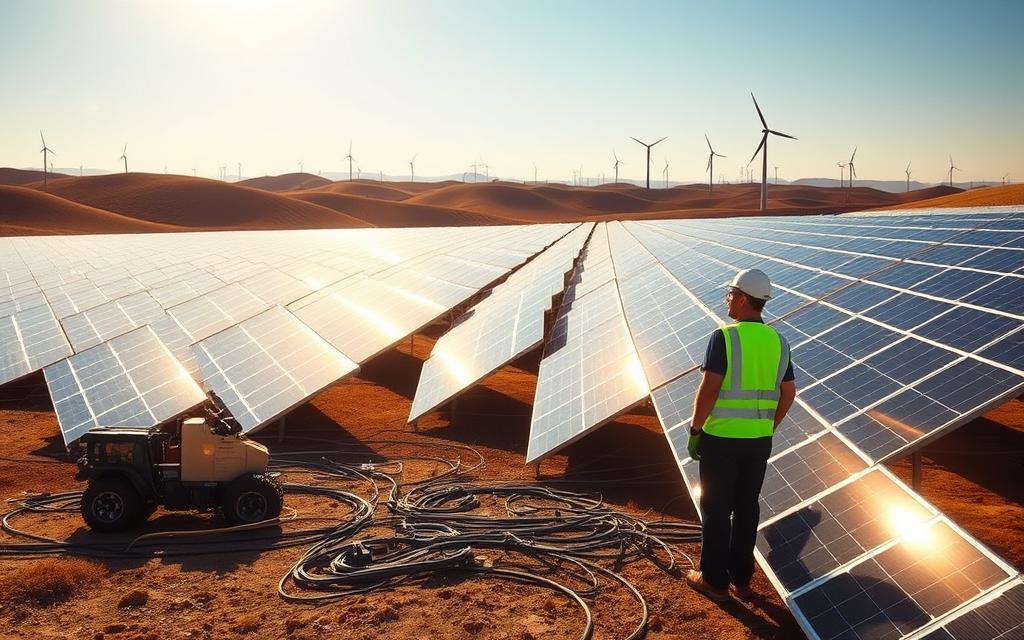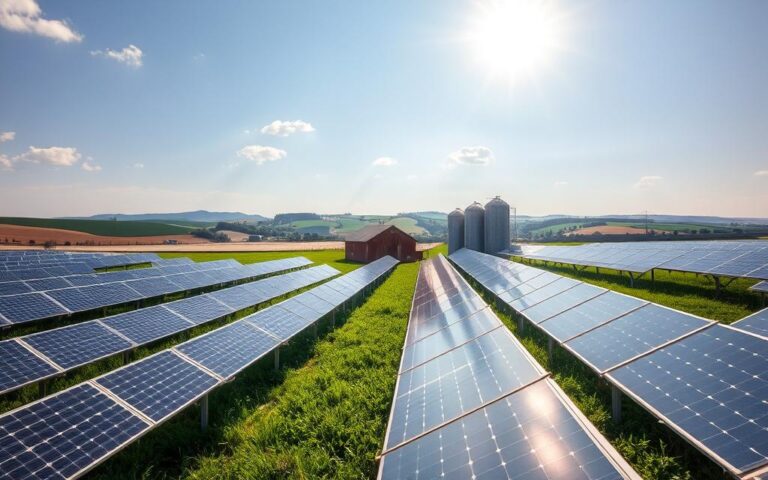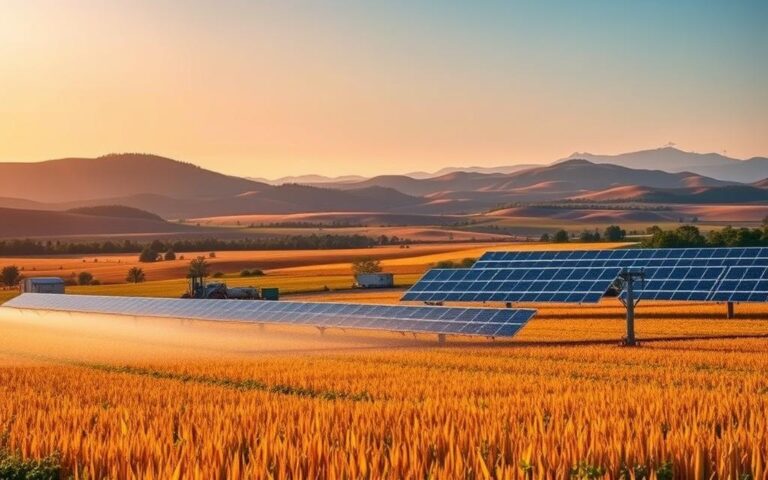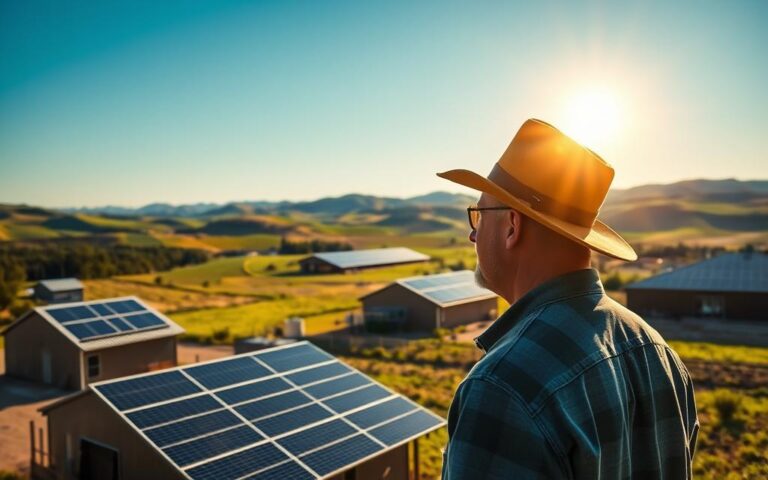Did you know over 25% of America’s farms use renewable energy? This move cuts their costs a lot. Setting up solar energy on your farm is smart and green. It makes your farm more profitable and sustainable.
This guide will help you set up a solar farm. We’ll cover the costs and benefits of using solar energy. Knowing the costs and benefits helps you make smart choices. You’ll learn to use the sun’s power, improve your farm, and help the environment.
Introduction to Solar Energy for Farms
Solar energy for farms is a game-changer in agriculture. With rising energy costs, farmers are turning to renewable energy. Solar power can cut down on electricity bills, helping farms save money.
Switching to solar energy brings financial gains and makes farms more stable. It ensures a steady energy supply, especially when energy needs are high. Solar energy also helps farms be more eco-friendly, meeting today’s green standards.
Solar panels can power important farm tasks like irrigation and refrigeration. By using solar energy, farms lead the way in renewable energy. They show they care for the land and save money on costs.
Understanding the Benefits of Solar Power for Agriculture
Using solar power in farming brings many benefits. One key advantage is saving money in the long run. Farmers can cut down on costs by using solar energy instead of traditional sources.
Another big plus is gaining energy independence. With solar panels, farms can make their own power. This means they’re not affected by price changes or power outages.
Going green is also a big win. Solar energy is clean and doesn’t harm the environment. It helps farms be more eco-friendly and meets the demand for sustainable products.
Finally, solar energy boosts farm productivity. It keeps important equipment running smoothly. This leads to more crops and better use of resources.
In summary, solar power in farming offers more than just saving money. It brings financial security, energy freedom, and helps the planet. Solar energy is a key step towards a greener and more productive farming future.
Assessing Your Energy Needs
It’s key to know your energy needs for a good solar system for your farm. By figuring out your energy needs, farmers can make sure their solar system works well. This starts with knowing how much energy you use, which helps decide how big your solar system should be.
Calculating Energy Consumption
To calculate energy use, start by listing all your farm’s appliances and tools. This includes things like irrigation pumps, coolers, and lights. You need to know how much power each uses and for how long. A Watt Hour chart can help show your energy use patterns.
Looking at these patterns helps find out when you use the most energy. This is important for planning your solar system.
Identifying Appliances and Equipment
Knowing what appliances you have is crucial. Group them by what they do and how much energy they use. Here are some main categories:
- Pumps and irrigation systems
- Heating and cooling units
- Refrigeration systems
- Lighting solutions
- Other machinery and equipment
This helps farmers decide which appliances are most important. By understanding your energy needs well, you can choose the right solar system for your farm.
| Appliance | Wattage | Hours Used/Day | Daily Energy Consumption (Wh) |
|---|---|---|---|
| Irrigation Pump | 1000 | 4 | 4000 |
| Cooling Unit | 3000 | 8 | 24000 |
| LED Lighting | 150 | 10 | 1500 |
| Refrigeration Unit | 500 | 24 | 12000 |
By carefully looking at your energy use, farmers can figure out their total needs. This ensures their solar system fits their farm’s energy needs well.
Choosing the Right Solar Components
Setting up a solar system on your farm requires picking the right parts. The right choice affects how well it works, its cost, and its overall value. Knowing about solar panels and batteries helps you make smart choices.
Types of Solar Panels: Monocrystalline vs. Polycrystalline
Monocrystalline and polycrystalline solar panels are key options. Monocrystalline panels are efficient and save space. They convert sunlight into electricity well because of their purity.
Polycrystalline panels are less efficient but cheaper. They’re good for big areas where saving space isn’t a big deal.
Here’s a quick comparison to help you decide:
| Panel Type | Efficiency | Cost | Temperature Coefficient |
|---|---|---|---|
| Monocrystalline | 15-22% | Higher | Better performance in higher temperatures |
| Polycrystalline | 13-16% | Lower | Less efficient in higher temperatures |
Selecting the Appropriate Batteries
Choosing the right batteries is key for reliable energy on your farm. Deep-cycle batteries are best for long-lasting power. Think about your energy needs when picking a voltage system.
Higher voltages can store more energy and support bigger systems. Look for batteries that balance capacity, lifespan, and cost for the best solar setup.
Solar Farm Installation Cost
Knowing the cost of setting up a solar farm is key to planning your budget. The cost can change a lot based on different factors. It’s important to know what these factors are to make smart financial choices.
Factors Influencing Installation Expenses
Many things affect the cost of installing solar panels. Key factors include:
- Location: Being close to the grid and the area you’re in can change labor and material costs.
- System Size: Bigger systems can get cheaper per watt because of economies of scale.
- Solar Panel Types: Monocrystalline panels cost more upfront but are more efficient, affecting overall costs.
Understanding these factors helps estimate your solar farm installation cost more accurately.
Comparing Costs of Solar Panel Systems
It’s helpful to compare utility-scale and residential solar systems to understand your investment. Here’s a table showing the differences:
| Aspect | Utility-Scale Solar Systems | Residential Solar Systems |
|---|---|---|
| Average Cost per Watt | $0.50 – $1.00 | $2.50 – $3.50 |
| Installation Complexity | Moderate | High |
| Regulatory Requirements | Extensive | Moderate |
| Typical Project Size | 1 MW and above | 5 kW to 10 kW |
The table shows utility-scale solar farms have lower installation costs. This is important for long-term planning. Knowing these details helps you make the best choices for your solar investment.
Obtaining Necessary Permits
Before starting a solar installation project, getting the right permits is key. Each state has its own rules for solar farms, and they can differ a lot. Knowing these rules is important to avoid delays in the installation.
Common permits include building, electrical, and sometimes environmental permits. These solar permits show that the installation follows local codes and safety rules. In some places, you might also need zoning permits, especially for big solar farms.
The process of getting permits can be tricky. Some states make it easier, while others require more paperwork and checks. Talking to local authorities early can help avoid problems. It’s also important to stay updated on any changes in solar farm laws to keep in compliance.
Here’s a table showing the different permits needed in various states in the U.S. It shows how different the rules can be:
| State | Building Permit | Electrical Permit | Environmental Permit | Zoning Permit |
|---|---|---|---|---|
| California | Required | Required | Required (if applicable) | Not typically required |
| Texas | Not required | Required | Not required | Required (in certain jurisdictions) |
| Florida | Required | Required | Required (for larger systems) | Required |
| New York | Required | Required | Required (if applicable) | Not typically required |
Knowing the legal requirements for solar farms helps manage the installation smoothly. This groundwork lets you move forward with confidence, setting up a successful solar energy project.
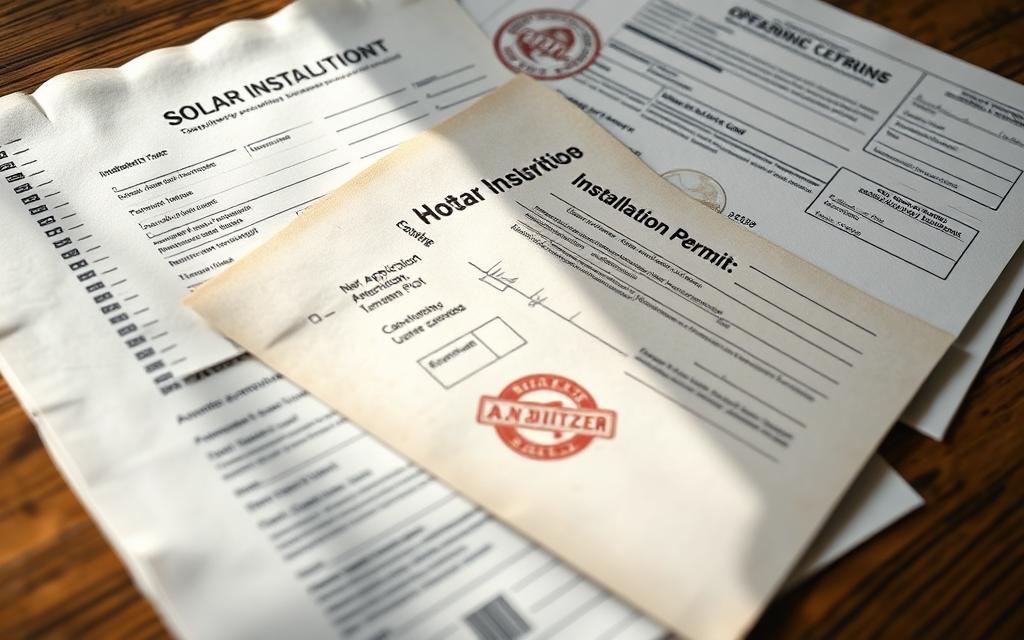
Hiring a Professional Installer vs. DIY Installation
Choosing between professional solar installers and DIY solar installation is key for your farm’s solar project. Each choice has its own benefits. Knowing these can help you decide wisely.
Advantages of Professional Installers
Going with professional solar installers means a smooth installation. They follow local rules and safety standards, important for big solar setups. Here are some main reasons to choose them:
- Expertise: They know the best ways to install.
- Time-saving: They work faster than doing it yourself.
- Warranty and Support: You get warranties and help after the job.
- Efficient Design: They make sure your system works its best.
Steps for a DIY Installation
If you’re thinking about doing it yourself, follow a clear plan. A DIY solar setup needs careful planning and doing. Here’s how to start:
- Research: Learn about solar systems to know what you need.
- Choose Components: Pick good panels, inverters, and batteries.
- Create a Plan: Make a detailed plan for your system’s layout.
- Installation: Start putting up the solar panels on your roof or ground mounts.
- Wiring: Connect the inverter and batteries to the panels, making sure all connections are tight.
- Testing: After connecting everything, test the system to make sure it works right.
- Documentation: Keep records of your setup for future use and inspections.
Connecting Your Solar System to the Grid
Connecting your solar energy system to the electric grid is a key step. It lets farmers use their solar energy efficiently. They can also make money from extra energy they produce.
The first step is to apply to your local utility company. You’ll need to share your solar system’s details, like the type and size of panels. The utility will check if your setup meets their standards and safety rules.
After approval, technicians will do inspections. They make sure everything works right and follows local codes. Then, the utility company will set up the needed equipment for the grid connection.
Net metering is important when connecting to the grid. It lets producers get credits for extra electricity. This can lower your electricity bills and make solar systems more profitable.
Connecting your solar system to the grid boosts your energy independence. It also helps in sustainable farming. By using solar energy, farmers use less fossil fuels and reduce their carbon footprint.
Maintenance and Upkeep of Your Solar System
Keeping your solar system running well needs regular care. It’s important to check your system often to catch problems early. You should inspect it at least twice a year.
Look at the connections, the panels’ condition, and how the inverters are doing. This helps keep everything working smoothly.
Cleaning your solar panels is also key. Dirt and dust can block sunlight, reducing how well they work. Clean them often, especially if you live in a dusty area.
Also, watch out for things that might block sunlight, like trees. Trimming trees or moving things can help a lot. If your system isn’t working right, check the inverters or get help from a pro.
Here’s a quick guide to keeping your solar system in top shape:
| Maintenance Task | Frequency | Notes |
|---|---|---|
| Visual Inspection | Twice a year | Check for physical damage and loose connections |
| Cleaning | As needed | Use water and a soft brush or hire professionals |
| Performance Monitoring | Monthly | Track energy output and look for drops in performance |
| Inverter Check | Annually | Ensure proper function and firmware is up to date |

Financing Your Solar Farm Project
Investing in solar energy is a big step for farmers. It’s important to explore financing options for solar farms. There are solar grants and incentives to help with the costs. Also, knowing the long-term savings can guide your decision-making.
Exploring Grants and Incentives
Government programs, non-profits, and utility companies offer solar grants and incentives. These can greatly reduce the cost of solar installation. For example, the federal investment tax credit (ITC) lets you deduct a big part of your solar costs from taxes. Local and state programs may offer more savings or rebates, so it’s worth checking what’s available in your area.
Understanding Long-term Savings
Solar energy can lead to big savings on energy bills over time. As solar panel prices drop and energy costs rise, many farmers see their utility bills go down. This can also increase your property’s value and protect you from higher electricity costs. Investing in solar now can lead to financial benefits in the future.
| Financing Options | Description | Potential Savings |
|---|---|---|
| Federal Investment Tax Credit (ITC) | Tax credit that allows you to deduct a percentage of solar costs from your federal taxes. | Up to 26% of installation cost, reducing tax liability. |
| State-Level Grants | State-sponsored financial aid for solar projects. | Varies by state; up to 30% off project costs. |
| Utility Rebates | Incentives provided by local utility companies to promote renewable energy use. | Typically range from $0.50 to $1.50 per watt. |
| Low-Interest Loans | Financing options designed to minimize interest rates for solar projects. | Can save thousands over the life of the loan. |
Future Considerations in Solar Energy
The future of solar energy looks bright for farms, thanks to new tech and innovations. Trends in solar technology are making solar panels more efficient. This means solar power could become a key part of farm energy.
New solar panel designs are setting records, making more energy in less space. This is great for farms with limited land. Also, better battery systems are coming to store solar energy. This will help farmers use energy day and night, even when it’s cloudy.
Government policies are changing to help solar energy grow. They offer incentives for using renewable energy. This encourages farmers to invest in solar, making farming more sustainable. Keeping up with these trends is key for farmers to make smart choices about energy.
Conclusion
Investing in solar power can change how farms work. It cuts down on energy costs and makes farming more sustainable. This shows that switching to renewable energy is smart and beneficial.
Starting with solar technology might seem hard. But, this guide helps farmers make good choices. It’s key to know your energy needs and pick the right parts for your system.
Getting help from experts is crucial. They can guide you through permits and installations. By going solar, farmers can make their operations more efficient and sustainable.

